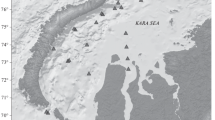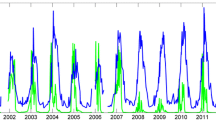Abstract
Metabolism (respiration and ammonia excretion rates) and chemical composition data [water content, ash, carbon (C), nitrogen (N) and C:N ratios] of a total of between 6–32 species of pteropods (thecosomes and gymnosomes) and heteropods from ≤500 m depth of the world’s oceans were compiled. Among the independent variables designated (body mass, habitat temperature, sampling depth, taxon), body mass and habitat temperature were significant predictors of metabolism, attributing to 85 % of the variance in respiration rates and 69 % of the variance in ammonia excretion rates. Atomic O:N ratios (respiration:ammonia excretion) ranged from 7.0 to 100 (median 14.5), and no appreciable effects of the variables were detected. A significant negative correlation of C and N compositions and habitat temperature was seen only in the thecosomes. As judged by the concomitant increase in C:N ratios with increasing habitat temperature, a greater deposition of inorganic C (as CaCO3–C) in the shell of the warmer-living species was suggested. Compared with other zooplankton (copepods, chaetognaths, and euphausiids), the thecosomes were characterized by higher respiration rates per unit body N and larger ash content by having possession of calcareous shells. Because of the shells, C and N composition expressed as % of dry mass of the thecosomes were lower than those of the other zooplankton taxa.




Similar content being viewed by others
References
Båmstedt U (1986) Chemical composition and energy content. In: Corner EDS, O’Hara SCM (eds) The biological chemistry of marine copepods. Clarendon, Oxford, pp 1–58
Beers JR (1966) Studies on the chemical composition of the major zooplankton groups in the Sargasso Sea off Bermuda. Limnol Oceanogr 11:520–528
Biggs DC (1977) Respiration and ammonia excretion by open ocean gelatinous zooplankton. Limnol Oceanogr 22:108–117
Brey T (2010) An empirical model for estimating aquatic invertebrate respiration. Method Ecol Evol 1:92–101
Ceccaldi HJ, Kanazawa A, Teshima S (1976) Chemical composition of some Mediterranean macroplanktonic organisms. 1. Proximate analysis. Tethys 8:295–298
Childress JJ (1995) Are there physiological and biochemical adaptation of metabolism in deep-sea animals? Trends Ecol Evol 10:30–36
Clarke A (1987) The adaptation of aquatic animals to low temperatures. In: Grout BWW, Morris GJ (eds) The effects of low temperatures on biological systems. Edward Arnold, London, pp 315–348
Clarke A, Fraser KPP (2004) Why does metabolism scale with temperature? Functional Ecol 18:243–251
Clarke A, Johnston NM (1999) Scaling of metabolic rate with body mass and temperature in teleost fish. J Anim Ecol 68:893–905
Comeau S, Gorsky G, Alliouane S, Gattuso JP (2010) Larvae of the pteropod Cavolinia inflexa exposed to aragonite undersaturation are viable but shell-less. Mar Biol 157:2341–2345
Comeau S, Gattuso JP, Jeffree R, Gazeau F (2012) Effect of carbonate chemistry manipulations on calcification, respiration, and excretion of a Mediterranean pteropod. Biogeosciences Discuss 9:6169–6189
Conover RJ, Lalli CM (1974) Feeding and growth in Clione limacina (Phipps), a pteropod mollusk. II. Assimilation, metabolism, and growth efficiency. J Exp Mar Biol Ecol 16:131–154
Curl H Jr (1962) Standing crops of carbon, nitrogen, and phosphorus and transfer between trophic levels, in continental self waters of New York. Rapp Proc Verb Cons Int Explor Mer 153:183–189
Davenport J, Trueman ER (1985) Oxygen uptake and buoyancy in zooplanktonic organisms from the tropical eastern Atlantic. Comp Biochem Physiol 81A:857–863
Fabry VJ, Seibel BA, Feely RA, Orr JC (2008) Impacts of ocean acidification on marine fauna and ecosystem process. ICES J Mar Sci 65:414–432
Francois R, Honjo S, Krishfield R, Manganini S (2002) Factors controlling the flux of organic carbon to the bathypelagic zone of the Ocean. Glob Biogeochem Cycles 16:34-1–34-20. doi:10.1029/2001GB001722
Gerber RP, Gerber MB (1979) Ingestion of natural particulate organic matter and subsequent assimilation, respiration and growth by tropical lagoon zooplankton. Mar Biol 52:33–44
Gillooly JF, Brown JH, West GB, Savage VM, Charnov EL (2001) Effects of size and temperature on metabolic rate. Science 293:2248–2251
Gilmer RW (1974) Some aspects of feeding in thecosomatous pteropod molluscs. J Exp Mar Biol Ecol 15:127–144
Gorsky G, Dallot S, Sardou J, Fenaux R, Carré C, Palazzoli I (1988) C and N composition of some northwestern Mediterranean zooplankton and micronekton species. J Exp Mar Biol Ecol 124:133–144
Honjo S (2004) Particle export and the biological pump in the Southern Ocean. Antarc Sci 16:501–516
Hunt BPV, Pakhomov EA, Hosie GW, Siegel V, Ward P, Bernard K (2008) Pteropods in Southern Ocean ecosystems. Prog Oceanog 78:193–221
Ikeda T (1974) Nutritional ecology of marine zooplankton. Mem Fac Fish Hokkaido Univ 22:1–97
Ikeda T (1985) Metabolic rates of epipelagic marine zooplankton as a function of body mass and temperature. Mar Biol 85:1–11
Ikeda T (1988) Metabolism and chemical composition of crustaceans from the Antarctic mesopelagic zone. Deep-Sea Res 35:1991–2002
Ikeda T (2008) Metabolism in mesopelagic and bathypelagic copepods: reply to Childress. Mar Ecol Prog Ser 373:193–196
Ikeda T (2013a) Respiration and ammonia excretion of euphausid crustaceans: synthesis towards a global-bathymetric model. Mar Biol 160:251–262
Ikeda T (2013b) Metabolism and chemical composition of marine pelagic amphipods: synthesis towards a global-bathymetric model. J Oceanogr 69:339–355
Ikeda T (2013c) Synthesis toward a global-bathymetric model of metabolism and chemical composition of mysid crustaceans. J Exp Mar Biol Ecol 445:79–87
Ikeda T, McKinnon AD (2012) Metabolism and chemical composition of zooplankton and hyperbenthos from the Great Barrier Reef waters, North Queensland, Australia. Plankton Benthos Res 7:8–19
Ikeda T, Mitchell AW (1982) Oxygen uptake, ammonia excretion, and phosphate excretion of krill and other Antarctic zooplankton, in relation to their body size and chemical composition. Mar Biol 71:283–298
Ikeda T, Skjoldal HR (1989) Metabolism and elemental composition of zooplankton from the Barents Sea during early arctic summer. Mar Biol 100:173–183
Ikeda T, Takahashi T (2012) Synthesis towards a global-bathymetric model of metabolism and chemical composition of marine pelagic chaetognaths. J Exp Mar Biol Ecol 424–425:78–88
Ikeda T, Torres JJ, Hernández-León S, Geiger SP (2000) Metabolism. In: Harris RP, Wiebe PH, Lenz J, Skjoldal HR, Huntley M (eds) ICES zooplankton methodology manual. Academic, San Diego, pp 455–532
Ikeda T, Kanno Y, Ozaki K, Shinada A (2001) Metabolic rates of epipelagic marine copepods as a function of body mass and temperature. Mar Biol 139:586–587
Ikeda T, Yamaguchi A, Matsuishi T (2006) Chemical composition and energy content of deep-sea calanoid copepods in the western North Pacific Ocean. Deep-Sea Res I 53:1791–1809
Ikeda T, Sano F, Yamaguchi A (2007) Respiration in marine pelagic copepods: a global-bathymetric model. Mar Ecol Prog Ser 339:215–219
Ivleva IV (1980) The dependence of crustacean respiration rate on body mass and habitat temperature. Int Revue ges Hydrobiol 65:1–47
Kruse S, Brey T, Bathmann U (2010) Role of midwater chaetognaths in Southern Ocean pelagic energy flow. Mar Ecol Prog Ser 416:105–113
Lalli CM, Gilmer RW (1989) Pelagic snails: the biology of holoplantonic gastropod mollusks. Stanford University Press, Stanford
Lee RF, Hagen W, Kattner G (2006) Lipid storage in marine zooplankton. Mar Ecol Prog Ser 307:273–306
Maas AE, Elder LE, Dierssen HM, Seibel BA (2011) Metabolic response of Antarctic pteropods (Mollusca: Gastropoda) to food deprivation and regional productivity. Mar Ecol Prog Ser 441:129–139
Maas AM, Seibel BA, Walsh PJ (2012a) Effects of elevated ammonia concentrations on survival, metabolic rates, and glutamine synthetase activity in the Antarctic pteropod mollusk Clione limacina antarctica. Polar Biol 35:1123–1128
Maas AE, Wishner KF, Seibel BA (2012b) The metabolic response of pteropods to ocean acidification reflects natural CO2—exposure in oxygen minimum zones. Biogeosciences 9:747–757
Maas AE, Wishner KF, Seibel BA (2012c) Metabolic suppression in thecosomatous pteropods as an effect of low temperature and hypoxia in the eastern tropical North Pacific. Mar Biol 159:1955–1967
Mayzaud P, Conover RJ (1988) O:N atomic ratio as a tool to describe zooplankton metabolism. Mar Ecol Prog Ser 45:289–302
Mayzaud P, Boutoute M, Gasparini S, Mousseau L (2005) Respiration in marine zooplankton—the other side of coin: CO2 production. Limnol Oceanogr 50:291–298
Nival P, Nival S, Palazzoli I (1972) Données sur la respiration de différent organismes communs dans le plankton de Villefranche-sur-Mer. Mar Biol 17:63–76
Norrbin F, Båmstedt U (1984) Energy contents in benthic and planktonic invertebrates of Kosterfjorden, Sweden. A comparison of energetic strategies in marine organism groups. Ophelia 23:47–64
Omori M (1969) Weight and chemical composition of some important oceanic zooplankton in the North Pacific Ocean. Mar Biol 3:4–10
Omori M, Ikeda T (1984) Methods in marine zooplankton ecology. Wiley, USA
Percy JA, Fife FJ (1981) The biochemical composition and energy content of arctic marine macrozooplankton. Arctic 34:307–313
Postel L, Fock H, Hagen W (2000) Biomass and abundance. In: Harris RP, Wiebe PH, Lenz J, Skjoldal HR, Huntley M (eds) ICES zooplankton methodology manual. Academic, San Diego, pp 83–192
Quetin LB, Ross RM, Uchio K (1980) Metabolic characteristics of midwater zooplankton: ammonia excretion, O:N ratios, and the effect of starvation. Mar Biol 59:201–209
Schneider G (1990) A comparison of carbon based ammonia excretion rates between gelatinous and non-gelatinous zooplankton: implications and consequences. Mar Biol 106:219–225
Seibel BA, Drazen JC (2007) The rate of metabolism in marine animals: environmental constraints, ecological demands and energetic opportunities. Philos Trans R Soc Lond B 362:2061–2078
Seibel BA, Dymowska A, Rosenthal J (2007) Metabolic temperature compensation and coevolution of locomotory performance in pteropod molluscs. Integr Comp Biol 47:880–891
Smith KL, Teal JM (1973) Temperature and pressure effects on respiration of thecosomatous pteropods. Deep-Sea Res 20:853–858
Sokal RR, Rohlf FJ (1995) Biometry. The principles and practice of statistics in biological research. Freeman, New York
Suárez-Morales E, Gaska R, Castellanos I (2009) Pelagic gastropods. In: Cortés J, Wehrtmann IS (eds) Marine Biodiversity of Costa Rica, Central America. Springer, Berlin, pp 357–369
Vinogradov AP (1953) The elementary chemical composition of marine organisms. Sears Foundation for Marine Research, New Haven
Acknowledgments
I am grateful to two anonymous reviewers whose comments improved the text. I thank D.A. McKinnon for editing early drafts of this paper.
Author information
Authors and Affiliations
Corresponding author
Appendix
Rights and permissions
About this article
Cite this article
Ikeda, T. Metabolism and chemical composition of marine pelagic gastropod molluscs: a synthesis. J Oceanogr 70, 289–305 (2014). https://doi.org/10.1007/s10872-014-0231-y
Received:
Revised:
Accepted:
Published:
Issue Date:
DOI: https://doi.org/10.1007/s10872-014-0231-y




